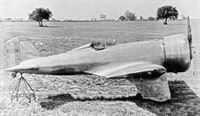Фотографии
-
Регистрационный номер: K5083 The prototype Hawker Hurricane, K5083, which first flew in November 1935. Note the small constant-radius wing fillet, thought to be adequate by its designer, Sydney Camm. The thick wing against the slightly curved fuselage-side meant that it was not, and the combination of the two resulted in considerable root-drag.
Самолёты на фотографии: Hawker Hurricane - Великобритания - 1935
-
The Gloster Meteor initially sported two teardrop-shaped engine nacelles (as seen left), creating separation and drag, as discovered in wool-tufting trials in 1944. Altering the shape so that longer nacelles (as right) gave straighter junctions and reduced pressure gradients delayed separation and added up to 50 m.p.h. (80km/h) to the aircraft’s maximum speed.
Самолёты на фотографии: Gloster Meteor / G.41 - Великобритания - 1943
-
Jack Northrop’s all-metal Alpha design of 1930 was a classic example of a fuselage of what was then considered “good aerodynamic design” running into trouble over the wing. Note the small wing fillet, similar to that of the Hurricane.
Самолёты на фотографии: Northrop Alpha - США - 1930
-
Before Muttray, Ower, Klein et al - or even the Short Mussel - was the German Pfalz D III biplane fighter of 1917, which was fitted with what would become established as the “right” fillet. Was this glimpse of the future incorporated by accident or design? If readers have any more information, do contact the Editor!
Самолёты на фотографии: Pfalz D.III - Германия - 1917
-
Регистрационный номер: G-AAZK The wreckage of Junkers-F 13 G-AAZK at Meopham, Kent, in July 1930. The port tailplane of the aircraft had separated before impact and was found some distance away. The German investigation blamed freak conditions in cloud, while British investigators looked at flow separation and buffeting.
Самолёты на фотографии: Junkers F 13 - Германия - 1919
-
Регистрационный номер: K2890 The Supermarine Type 224, built to Specification F.7/30, was fitted with a fillet and tested with wool tufts to measure airflow separation. Curiously, the aircraft’s anhedral on its inner wing section and flat sides would probably have made these fillets redundant in any case.
Самолёты на фотографии: Supermarine Type 224 - Великобритания - 1931
-
Регистрационный номер: G-EBMJ Named in honour of Mussel Manor, the clubhouse near the Short brothers’ first aeroplane factory on the Isle of Sheppey, the Short S.7 Mussel I, G-EBMJ, is seen here at Rochester in July 1926. The pinnacle of streamlined design at the time, the metal two-seat floatplane was transformed by simple fabric fillets, clearly visible here.
Самолёты на фотографии: Short Mussel / S.7 - Великобритания - 1926
-
Регистрационный номер: X12214 The second of the two Northrop Betas, with a Pratt & Whitney Wasp Junior engine. The Beta incorporated Arthur Klein’s elegant “expanding fillet”, as used later on the Douglas Commercials. Klein meticulously calculated “right”and “wrong” fillets.
Самолёты на фотографии: Northrop Beta - США - 1931
-
The Doodlebug mounted in the full-scale windtunnel at NACA’s Langley establishment in 1934. As predicted, the large wing fillets seen here reduced buffeting considerably. The improvement in the aircraft’s drag was considered almost incidental.
Самолёты на фотографии: McDonnell Doodlebug - США - 1929
-
With a wing and fuselage geometry similar to the Junkers-F 13, the one-off McDonnell Doodlebug, the wing/fuselage junction of which is seen here with no modification, was selected by NACA to explore the effect of various interference-reducing measures.
Самолёты на фотографии: McDonnell Doodlebug - США - 1929
Статьи
- -
- A.Delalande - All the president's men
- C.Gibson - What is Rechlin 104? Germany's mystery cargo aircraft
- C.Higgs - Proof positive
- E.Bryan - A lot less bother by hover!
- L.Gaylard - The fall of Damien
- M.Bearman - Tunnel vision
- M.Willis - "Very nearly a good aeroplane..."
- N.Stroud - Off to Butlin's /The John Stroud Archive/
- P.Davidson - Off the Beaten Track...
- P.Jarrett - Lost & Found
- P.Jarrett - Sidney Camm's long-lost triplane
- R.Lezon - The Walrus in Argentina
- R.Mulder - Crossing the Deep
- R.Riding, A.Stephenson - What a woman! Janet Ferguson: ferry pilot extraordinare
- T.Buttler - TSR.2's company: Hawker P.1129









